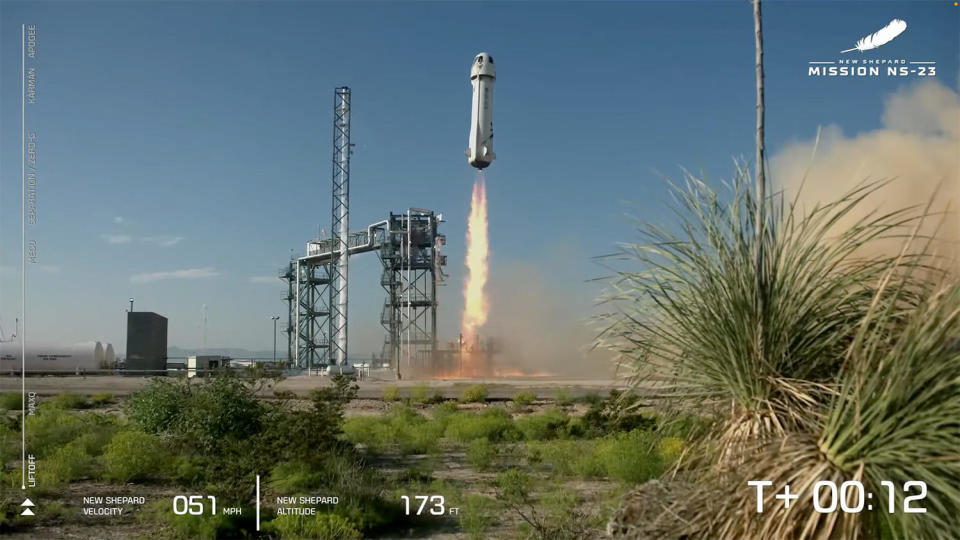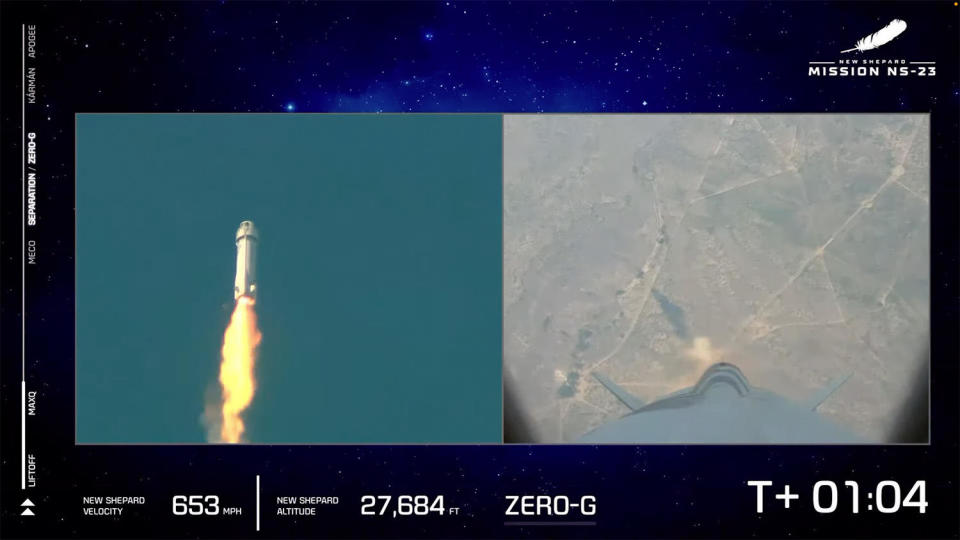New Shepard launch abort blamed on engine nozzle failure, Blue Origin says
Structural failure of the nozzle at the base of a rocket engine powering an un-piloted New Shepard spacecraft toward the edge of space in September of 2022 triggered a dramatic-but-safe in-flight abort, builder Blue Origin announced Friday, saying the company has identified fixes and plans to resume sub-orbital flights "soon."
"The direct cause of the NS-23 mishap was a thermo-structural failure of the engine nozzle," Blue Origin said in a statement. "The resulting thrust misalignment properly triggered the Crew Capsule escape system, which functioned as designed throughout the flight. The Crew Capsule and all payloads on board landed safely and will be flown again."
The company did not say exactly when flights might resume, only that Blue Origin "expects to return to flight soon, with a re-flight of the NS-23 payloads."

Owned by Amazon-founder Jeff Bezos, Blue Origin built the New Shepard system to carry passengers and microgravity experiments on up-and-down flights to the edge of space some 65 miles up. After about three minutes of weightlessness, the capsules fall back to Earth with a parachute-assisted touchdown near the launch pad.
The aborted flight on Sept. 12, 2022, was Blue Origin's 23rd and the fourth of that year. Six of the last eight missions dating back to July 2021 carried passengers, including Bezos. Two of the eight most recent flights, including the aborted mission, carried cargo only using a capsule specifically reserved for that purpose.
The ill-fated NS-23 mission began when the hydrogen-fueled BE-3 engine powering the single-stage New Shepard "power module," or booster, roared to life, propelling the spacecraft skyward from Blue Origin's west Texas launch site.
The early moments of the flight appeared normal as the rocket accelerated toward space, but one minute and four seconds after liftoff, the BE-3 exhaust plume changed color slightly and an instant after that, a large burst of flame erupted from the base of the rocket.

In a fraction of a second, the New Shepard capsule's abort motor ignited with a rush of flaming exhaust, instantly pushing the spacecraft away from the malfunctioning booster. It then made what appeared to be a normal parachute descent.
The booster, meanwhile, automatically shut down the BE-3 engine and the rocket crashed back to Earth within the pre-defined launch hazard zone. There was no property damage on the ground and no personnel were injured.
Here's Blue Origin's launch webcast. The launch and nozzle failure occur toward the end of the video:
A lengthy failure investigation included Blue Origin engineers, the Federal Aviation Administration, NASA and independent analysts who studied onboard video, recovered wreckage, telemetry and laboratory testing.
The investigators determined "the direct cause of the mishap to be a structural fatigue failure of the BE-3PM (power module) engine nozzle during powered flight."
The higher temperatures and visible "hot streaks" in recovered nozzle fragments were caused by "design changes made to the engine's boundary layer cooling system."
"Blue Origin is implementing corrective actions, including design changes to the combustion chamber and operating parameters, which have reduced engine nozzle bulk and hot-streak temperatures," the company said. "Additional design changes to the nozzle have improved structural performance under thermal and dynamic loads."
While the next New Shepard flight will carry the same experiments that were launched in the September abort, Blue Origin provided no guidance on when passenger flights might resume.
60 Minutes' 2003 investigation of intelligence that led to Iraq War

 Yahoo Autos
Yahoo Autos 